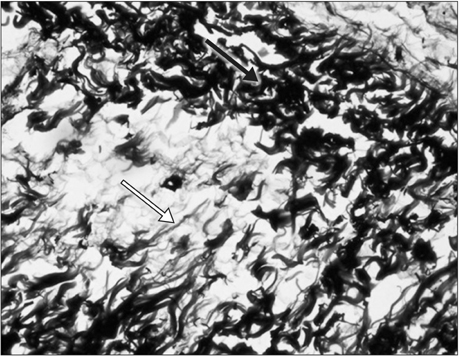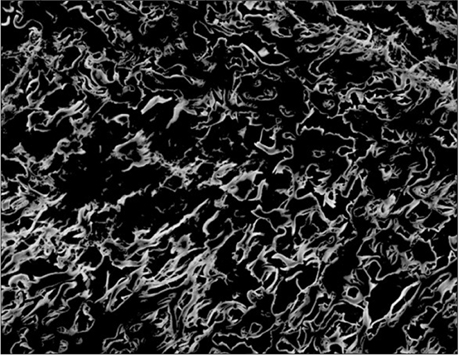Anat Cell Biol.
2016 Sep;49(3):184-188. 10.5115/acb.2016.49.3.184.
Histological and biochemical study of the superficial abdominal fascia and its implication in obesity
- Affiliations
-
- 1Department of Anatomy, Kasturba Medical College, Manipal University, Manipal, India. arvind.pandey@manipal.edu
- 2King Abdul Aziz Hospital, Ministry of Health, Sakaka, Saudi Arabia.
- 3Department of Physics, Manipal Institute of Technology, Manipal University, Manipal, India.
- 4Department of Plastic Surgery, Kasturba Medical College, Manipal University, Manipal, India.
- 5School of Information Sciences, Manipal University, Manipal, India.
- KMID: 2353343
- DOI: http://doi.org/10.5115/acb.2016.49.3.184
Abstract
- The advancement of liposculpturing and fascial flaps in reconstructive surgery has renewed interest in the superficial fascia of abdomen. Its histological and biochemical composition may play a vital role in maintaining strength and elasticity of the fascia. Hence, study of abdominal fascia for the elastic, collagen, and hydroxyproline contents is desirable to understand asymmetrical bulges and skin folds and in improving surgical treatment of obesity. Samples of superficial fascia were collected from of upper and lower abdomen from 21 fresh cadavers (15 males and 6 females). Samples were stained using Verhoeff-Van Gieson stain. Digital images of superficial fascia were analyzed using TissueQuant software. The samples were also subjected to hydroxyproline estimation. The superficial fascia was formed by loosely packed collagen fibers mixed with abundant elastic fibers and adipose tissue. Elastic contents and collagen contents of superficial fascia were significantly more in the upper abdomen than that in the lower abdomen in males. Hydroxyproline content of superficial fascia of upper abdomen was significantly more than that of lower abdomen in both males and females. The elastic, collagen and hydroxyproline contents of superficial fascia of upper abdomen were higher compared to the lower abdomen. This may be a reason for asymmetric bulging over abdomen and more sagging fold of skin in the lower abdomen than in the upper abdomen. This study may therefore be helpful in finding new ways to manage obesity and other body contour deformities.
MeSH Terms
Figure
Reference
-
1. Stecco C, Macchi V, Porzionato A, Duparc F, De Caro R. The fascia: the forgotten structure. Ital J Anat Embryol. 2011; 116:127–138.2. Ullah M. Histology and genetics: theoretical and applied. Meerut: Kedarnath Ram Nath Publishers;1980. p. 280–284.3. Singh IB. Textbook of human histology. 4th ed. New Delhi: Jaypee Brothers' Medical Publishers;2004. p. 58–60.4. Kumar P, Pandey AK, Kumar B, Aithal SK. Anatomical study of superficial fascia and localized fat deposits of abdomen. Indian J Plast Surg. 2011; 44:478–483.5. Yusuf S, Hawken S, Ounpuu S, Dans T, Avezum A, Lanas F, McQueen M, Budaj A, Pais P, Varigos J, Lisheng L. INTERHEART Study Investigators. Effect of potentially modifiable risk factors associated with myocardial infarction in 52 countries (the INTERHEART study): case-control study. Lancet. 2004; 364:937–952.6. Neuman RE, Logan MA. The determination of hydroxyproline. J Biol Chem. 1950; 184:299–306.7. Jalan AA, Demeler B, Hartgerink JD. Hydroxyproline-free single composition ABC collagen heterotrimer. J Am Chem Soc. 2013; 135:6014–6017.8. Montes GS. Structural biology of the fibres of the collagenous and elastic systems. Cell Biol Int. 1996; 20:15–27.9. Ushiki T. Collagen fibers, reticular fibers and elastic fibers. A comprehensive understanding from a morphological viewpoint. Arch Histol Cytol. 2002; 65:109–126.10. Eroschenko VP. DiFlore's atlas of histology with functional correlations. 11th ed. Philaedelphia: Lippincott Williams & Wilkins;2008. p. 56–66.11. Illouz YG, DeVillers YT. Body sculpturing by lipoplasty. Edinburgh: Churchill Livingstone;1989. p. 29–32. p. 5112. Fodor PB. Reflections on lipoplasty: history and personal experience. Aesthet Surg J. 2009; 29:226–231.13. Matarasso A. Traditional abdominoplasty. Clin Plast Surg. 2010; 37:415–437.14. Bancroft JD, Gamble M. Theory and practice of histological techniques. 5th ed. Edinburgh: Churchill Livingstone;2002.15. Chakravarthy Marx S, Kumar P, Dhalapathy S, Prasad K, Anitha Marx C. Microanatomical and immunohistochemical study of the human radial nerve at the antecubital fossa. Ann Anat. 2009; 191:389–398.16. Prasad K, P BK, Chakravarthy M, Prabhu G. Applications of 'TissueQuant': a color intensity quantification tool for medical research. Comput Methods Programs Biomed. 2012; 106:27–36.17. Prabhu V, Rao SB, Fernandes EM, Rao AC, Prasad K, Mahato KK. Objective assessment of endogenous collagen in vivo during tissue repair by laser induced fluorescence. PLoS One. 2014; 9:e98609.18. Kumar N, Kumar P, Prasad K, Nayak BS. A histological study on the distribution of dermal collagen and elastic fibres in different regions of the body. Int J Med Med Sci. 2012; 4:171–176.19. Reddy S, Kumar P, Prasad K. Histomorphometric and sympathetic innervation of the human internal thoracic artery. Clinics (Sao Paulo). 2011; 66:131–136.
- Full Text Links
- Actions
-
Cited
- CITED
-
- Close
- Share
- Similar articles
-
- Safety of Elevation from Superficial Fascial Plane versus Traditional Deep Fascial Plane for Flap Elevation in a Porcine Model
- Characteristics of Fat Tissue According to the Anatomical Regions of the Body: Computed Tomographic and Histological Findings
- Ear Elevation using the Superficial Temporal Fascia Harvested Through Minimal Incision
- Comparison of Fixation of the Rectus Fascia to the Cooper's Ligament and Abdominal Wall in Pubovaginal Sling Operation
- Surgical Anatomy of the Breast for Mammaplasty Using Breast Implants




